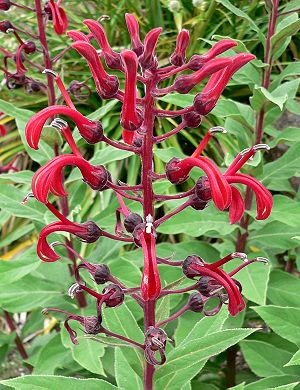Devil tobacco
| Devil tobacco | ||||||||||||
|---|---|---|---|---|---|---|---|---|---|---|---|---|

Devil tobacco ( Lobelia tupa ) |
||||||||||||
| Systematics | ||||||||||||
|
||||||||||||
| Scientific name | ||||||||||||
| Lobelia tupa | ||||||||||||
| L. |
The devil tobacco ( Lobelia tupa ) is a plant from the genus of lobelia ( Lobelia ) within the family of the bell flower plants (Campanulaceae). It comes from Chile and is used as an ornamental plant in parks and gardens. The common name devil tobacco refers to its use as a psychoactive drug by the Mapuche people , who traditionally smoke parts of plants in religious ceremonies, which Christian missionaries saw as the work of the devil.
description
Vegetative characteristics
Devil tobacco is a sturdy, perennial herbaceous shrub or subshrub and reaches heights of 0.5 to 3 meters. A plant specimen is multi-stemmed from the base, but the stems no longer branch in the upper area. The hollow stems are densely hairy and contain white milky sap that escapes when injured.
The leaf base of the sitting leaves continues as a short, narrow wing a little down on the stem, rarely it is wedge-shaped and wingless. The simple leaf blade is 4.5 to 25.5 centimeters long and 1.2 to 7.8 centimeters wide, oblong-egg-shaped to narrowly elliptical, rarely lanceolate and pointed at the end, occasionally spiky. The leaf margin is finely to very finely serrated. Both the top and the bottom are densely hairy.
Generative characteristics
The terminal, racemose inflorescence contains 10 to 65 flowers. The bracts are ovate to lanceolate with a length of about 45 millimeters. There are no cover sheets. The flower stalks are 8 to 30 millimeters long.
The relatively large flowers are zygomorphic and five-fold with a double flower envelope . There is a hemispherical flower cup . The 2 to 8 millimeter long calyx lobes are narrowly triangular and usually spiky. The 31 to 49 millimeter long corolla is bright red, very rarely also yellow. The long, curved, short-haired corolla tube has a diameter of only 2 to 4 millimeters and ends in a free corolla lobe, which is slightly shorter than the corolla tube. The long anthers tube formed from the five intergrown stamens is colored red, just like the corolla.
The flowering period in the natural habitat ranges from late October to early April.
Differentiation from related species
Lobelia tupa can be distinguished from the related species Lobelia polyphylla and Lobelia excelsa , which also occur in Chile, by the herbaceous growth habit (these are shrubs). Of Lobelia bridgesii the red flower color are different (in this pink) and the hairy, in the end only pointed but not grannenartig extended leaves.
ecology
The devil tobacco is pollinated by hummingbirds . Some species of bees are able to steal the nectar without fertilization by biting open the corolla tube .
Occurrence
The devil tobacco is endemic to Chile. It grows in the southern part of central Chile in the area of deciduous forests and evergreen temperate rainforests , usually in clearings and on the edge of the forest, such as the edges of paths and brooks. It grows at altitudes from sea level to about 400 meters, exceptionally also up to 940 meters.
Systematics and research history
The species Lobelia tupa belongs to the section Tupa ( Syn .: Eutupa ) in the subgenus Tupa within the genus Lobelia .
This species was first known in Europe by the French missionary and explorer Louis Feuillée , who mentions and describes a plant in the report of his research trip to Chile (1707 to 1712), which the Mapuche call "tupa". Carl von Linné adopted this species in his work Species Plantarum based on the description and illustrations by Feuillée and placed it in the genus Lobelia . In the 19th century, numerous species were re-described in European botanical gardens on the basis of plant specimens, many of which turned out to be synonyms .
use
Since the dried leaves of the devil tobacco were smoked by the Mapuche as part of ritual religious ceremonies, which the Christian missionaries suspected of idolatry, the Spanish-speaking colonizers referred to the plant as tabaco del diablo ; this name was translated for the English and German language name. Ingredients are lobeline and other piperidine and pyridine alkaloids , but the plant has been poorly researched pharmacologically so that the basis of the psychoactive effects is unknown. The extracted milky juice of the devil tobacco is also used in Chile against toothache. The plant parts are poisonous, so all uses are considered highly risky. Feuillée even claimed that the fragrance of the flowers was enough to induce nausea. The latex juice , if it gets in the eyes, can cause blindness.
As an ornamental plant, devil tobacco is frost hardy to around −10 ° C (USDA frost hardiness zone 8). It can be used in sunny or partially shaded locations on all types of soil. The flowering time in Europe is autumn (September to October).
swell
- Thomas G. Lammers: Revision of Lobelia sect. Tupa (Campanulaceae: Lobelioideae). In: SIDA Contributions to Botany , Volume 19, Issue 1, 2000, pp. 87-110. JSTOR 41967755 Lobelia tupa from p. 100.
Individual evidence
- ^ Lobelia tupa at Plants For A Future . Retrieved February 26, 2016.

